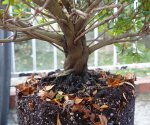Bonsai Nut
Nuttier than your average Nut
And, really, when have you ever seen a single trunk azalea that's not a bonsai? Frankly, I never have. They're bushes. Multiple trunks. Only when someone forces their will upon it will an azalea grow as a single trunk tree (or bush). So, the entire concept of a single trunk azalea is unnatural.
Gotcha! I picked this up yesterday for $29.98










